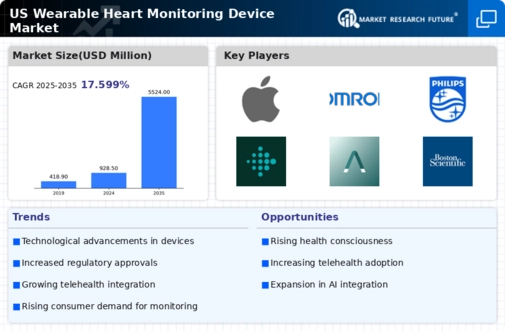Growing Health Awareness
The increasing awareness of health and wellness among the population appears to be a primary driver for the wearable heart-monitoring-device market. As individuals become more conscious of their cardiovascular health, the demand for devices that can monitor heart rates, rhythms, and other vital signs is likely to rise. According to recent data, approximately 70% of adults in the US express interest in using wearable technology to track their health metrics. This trend suggests that consumers are actively seeking tools that empower them to take control of their health, thereby propelling the growth of the wearable heart-monitoring-device market.
Aging Population and Chronic Diseases
The demographic shift towards an aging population in the US is a crucial factor influencing the wearable heart-monitoring-device market. As the population ages, the prevalence of chronic diseases, particularly cardiovascular conditions, is expected to rise. Data indicates that nearly 50% of adults aged 65 and older have some form of heart disease. This demographic is increasingly adopting wearable technology to monitor their health proactively. Consequently, the demand for heart-monitoring devices is likely to grow, as these tools provide essential data for managing chronic conditions and improving overall health outcomes.
Technological Advancements in Wearables
Technological innovations in the wearable heart-monitoring-device market are driving significant growth. The integration of advanced sensors, artificial intelligence, and machine learning algorithms enhances the accuracy and functionality of these devices. For instance, the market has seen a surge in devices capable of providing real-time data analysis and alerts for irregular heartbeats. This technological evolution not only improves user experience but also increases the reliability of health monitoring. As a result, the market is projected to expand at a compound annual growth rate (CAGR) of around 15% over the next five years, indicating a robust demand for sophisticated wearable heart-monitoring devices.
Insurance Incentives for Health Monitoring
Insurance companies in the US are increasingly recognizing the value of preventive health measures, which is positively impacting the wearable heart-monitoring-device market. Many insurers now offer incentives for policyholders who utilize wearable devices to monitor their health. This trend suggests that insurance providers are promoting the use of technology to reduce long-term healthcare costs. For example, some companies provide discounts or rewards for users who meet specific health goals tracked by their devices. This shift not only encourages the adoption of wearable heart-monitoring devices but also fosters a culture of health awareness among consumers.
Integration with Fitness and Lifestyle Apps
The integration of wearable heart-monitoring devices with fitness and lifestyle applications is emerging as a significant driver in the market. Many consumers are seeking comprehensive health solutions that combine heart monitoring with fitness tracking, nutrition, and wellness management. This trend indicates a growing preference for devices that offer holistic health insights. As a result, partnerships between wearable device manufacturers and app developers are becoming more common, enhancing the functionality and appeal of these products. This integration is likely to attract a broader audience, further stimulating growth in the wearable heart-monitoring-device market.
























Leave a Comment